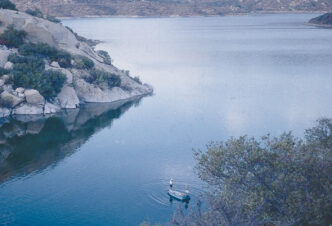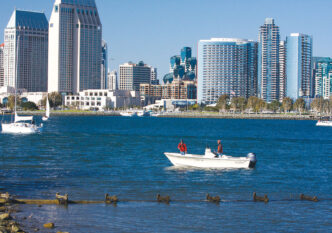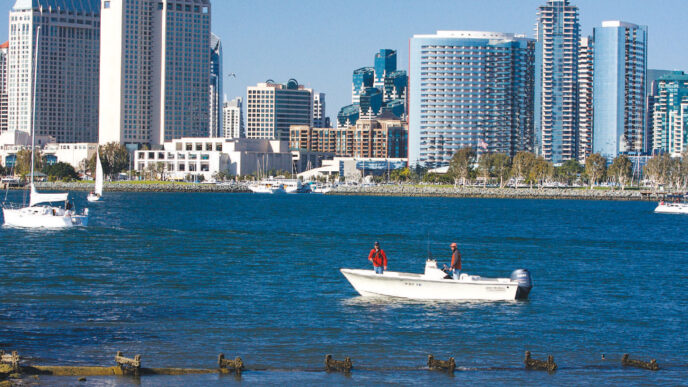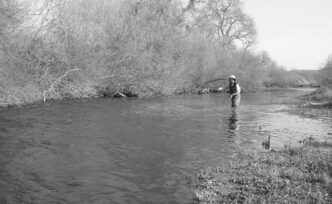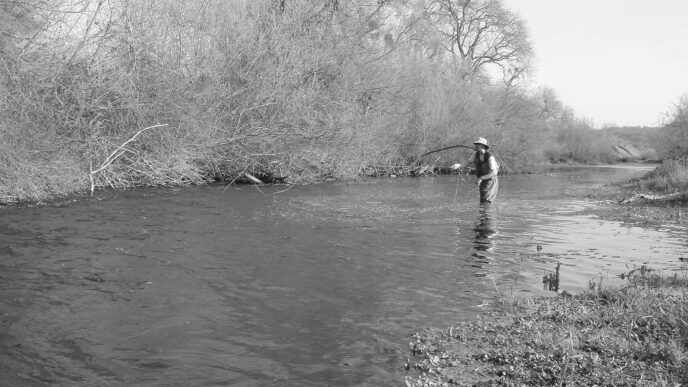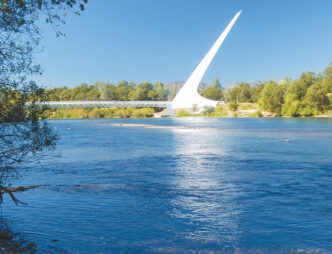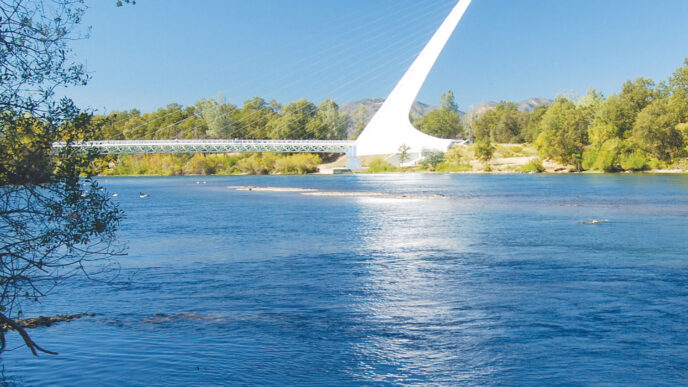California hosts some of the finest trout fisheries in the West, but many anglers are surprised to learn that the state — Southern California, in particular — also offers some of the best bass fishing to be found anywhere. While you can catch bass as far north in California as you wish to go, it’s the waters surrounding the big cities of the Southland where most of the top angling is to be found. Water departments and water managers in the urban areas of Southern California have added recreational sport fishing to their list of approved activities.
Starting at about Lake Isabella and stretching all the way down to lakes such as Barrett and Otay in the extreme south of San Diego County, there are many good and a few great bass fisheries. Some of these offer the fly-rod angler real promise in the spring, when fish are at reasonable depths for fly gear, but they also do so again in autumn. Simply by watching the average air temperatures and monitoring surface water temperatures, you can find still waters worth visiting all fall, which is one of the longest “seasons” in Southern California. Some lakes come into their fall season as late as November. What follows is a list of the best bass hot spots in Southern California.
Kern County
Lake Isabella, a huge impoundment in Kern County, typically gets massive runoff from the Sierra during the spring and early summer. This is usually when it fishes best, with the angling tapering off a bit by July and August, but then rebounding beginning in late September and continuing until the first storms of winter. Depending on a number of factors, such as weather and how much water is needed down in the valley around the community of Bakersfield, the lake level may be up or it may be down, but in either case, anglers are left with thousands of surface acres of water to fish. At full pool, Lake Isabella has something like 11,000 surface acres.
Fly fishers can wade or float tube this big lake, but a better method is using a sturdy and capable boat to move about. Lake Isabella is often windy and can quickly swamp a small or underpowered watercraft. The basic method when angling with a boat is to search for largemouth bass that are hunting schools of shad and other baitfish. Techniques vary, but the best strategy on a large lake such as this is to watch for surface activity. This can be anything from “nervous water” indicating a school of baitfish at the surface to a squawking, swirling horde of gulls or other diving birds. A lake this large makes a pair of binoculars a tool that should be in every angler’s kit.
Rigged with a sinking line and a streamer pattern that mimics the baitfish being preyed on by the bass, either cast blind to the surface of a cove or wait until surface feeding begins somewhere. Then make a fast approach, cutting the gas engine and coasting within casting range of the melee.
Casting into the surface boil, then letting the streamer fly sink like an injured baitfish, usually will draw a strike. You can catch anything from hand-sized bass up to wall hangers so big you won’t believe it.
In addition to the fall action on largemouths at Lake Isabella, there’s also the smallmouth bass bite on the lower Kern River to think about. In the late summer and all through the fall, the flow rates on the lower Kern, especially the first few miles above the city of Bakersfield, get low enough for comfortable wading.
It’s during this time that you can take advantage of the lower Kern’s really good smallmouth bass fishery. A note of warning, though: you don’t want to try to wade during the high flows of spring. The lower Kern kills swimmers and waders every year. Don’t be one of the casualties. When conditions are right, though, you can wade miles of the lower Kern, fishing either poppers or dry flies, and catch smallmouth bass. For more information on both the lake and the lower river, stop by the Kern River Fly Shop in Kernville or phone (760) 376-2040.
San Bernardino County
In land area, San Bernardino County is the largest in California. It is larger than a number of Eastern states. Most of the county, however, is desert, with fishing concentrated in the southwest corner and on the east end along the Colorado River.
First on a short list of opportunities for bass angling is Silverwood Lake. This is a California Water Project storage reservoir of about 1,000 surface acres. It is a typical canyon reservoir, steep and deep, built at the junction of two small creeks in the San Bernardino National Forest.
As a stop on the California Aqueduct, Silverwood constantly has water flowing in and out of it. This creates a slow, but measurable current in the lake. All the various fish species that live in the lake respond to this current, and that alone should tell you where and how to fish it. In addition to largemouth bass, Silverwood has striped bass, bluegills, crappies, and in the winter, stocked trout. California’s state parks have been in the grip of the budget woes that plague the Golden State, but it appears there will sufficient funding to keep the park open seven days a week for the winter months of 2013–2014.
Big and often covered with whitecaps due to the strong winds that blow most afternoons, Silverwood, like Lake Isabella, can be a better lake for powerboaters than for float tubers. Mornings are usually still, though, so keep that in mind. The lake’s large coves and brushy areas offer bass plenty of hiding places, and flies of modest size, fished on sinking lines, are the key to doing well at Silverwood. This lake’s altitude is just under 4,000 feet, and its location on the edge of the desert stretches the fall season into mid-November and later. For more information, call the Silverwood Lake office at (760) 389-2281 or check out the lake Web site at http://www.parks.ca.gov/?page_id=650.
The other large bass lake in San Bernardino County is Big Bear Lake. Higher than Silverwood, at nearly 7,000 feet, Big Bear would seem to be the ideal trout lake, and it does have a fine put-and-take trout fishery. (Big Bear Lake’s tiny tributaries usually don’t provide decent spawning habitat.) But in addition to trout, Big Bear has a surprisingly good bass fishery for both largemouths and smallmouths. September and October are generally the best months of the fall season for bass at Big Bear. It begins to get very cold in November, so warmwater fishing is pretty much over by then.
Unlike most of the black bass waters in Southern California, Big Bear has little in the way of shad or other small, silvery baitfish. Prey species here are bluegills, crappies, sunfish, and the young of the catfish population. Instead of selecting a white fly such as a Clouser Minnow, try something that resembles a small bluegill or other panfish species.
Big Bear has wonderfully varied structure. Much of the south shore of the lake is rocky and steep, while the slope of the north side is more gradual, offering spots to wade and cast bass bugs. Grout Bay, near the small town of Fawnskin, is ideal summer bass and panfish habitat, but the fishing there tapers off in the fall.
The Big Bear Municipal Water District Web site is http://www.bbmwd.com/Home.html. It has most all the information you will need to fish this beautiful mountain lake.
Riverside County
Diamond Valley Reservoir, near the community of Hemet, is an impressive bass fishery. It is not, however, a fly-friendly water. Only a small portion of this enormous lake’s shore is open to angling on foot. You cannot wade or float tube at this lake, and about the only way to fish it is either by renting a boat at the marina or by bringing your own. There are a few well-equipped fly anglers who fish it quite often and do pretty well, but I can’t recommend it for most. However, it is at a low enough altitude to extend its bass season well into November and to start up again by mid-March most years. For more information, see the Diamond Valley Marina Web site at http://www.dvlake.com.

On the other hand Lake Perris, which is a state park, allows the use of float tubes, and you can wade-fish a lot of the north end during the spring spawn. Perris, at an elevation of just under 1,600 feet, often has warm winter days and winter trout plants that bring big largemouths up to feed in shallow water. This is a very good bass lake. It currently is undergoing a prolonged drawdown that reduces its surface acreage from around 2,000 acres to a slightly smaller 1,600 acres or so. It will be several years before the lake level comes back up. Still, Perris has lots of brush and other cover and can be a good bass lake in the fall. It’s still too hot in September, though, so start thinking about fishing it in October. This is roughly when the winter trout plants start, which is a good time to begin fishing for really big largemouth bass using streamers, small ones that mimic threadfin shad up to huge streamers that look like hatchery trout. For information, go to the Lake Perris State Recreation Area website at gov/?page_id=651.
Another low-altitude bass lake is Lake Skinner, a Riverside County Park water that has a population of largemouths to about eight pounds or so. Due to its altitude, just 1,500 feet, it is a good late fall and early winter bass lake. Its drawbacks are much the same as Diamond Valley Lake. No wading or float tubes are allowed, which makes Skinner a boater’s lake. For information, see the Riverside County Parks Web site for Lake Skinner at skinner/lake-skinner-home.
Riverside County has only one bass fishery at an altitude high enough to be interesting to late summer and early fall anglers. Lake Hemet, located on Mount San Jacinto at an altitude of 4,500 feet, is a reservoir of 420 surface acres that is primarily recognized as a trout fishery, but also has a population of largemouth bass.
You can’t float tube Lake Hemet, either, but you can wade a large portion of the shore along an area known as the “Government Strip” on the north side of the lake. You can also launch your own boat or rent one. Lake Hemet is a very good bass and panfish lake through the summer and well into the fall. For more on Lake Hemet, go to http://www.lakehemet.org.
Los Angeles County
It may surprise some anglers, even those who live in Los Angeles, but L.A. County does have a few fishing destinations worthy of a close look. For the warmwater fly angler, the primary destination for largemouth during autumn is 2,230-surface-acre Castaic Lake. Actually, there are two waters here you’ll want to investigate. The larger, or “main lake,” is a huge, steep-sided, V-shaped reservoir, while the smaller forebay is just 180 surface acres, but has some of the largest bass to be found in Castaic’s waters. As in many Southern California lakes, the primary forage for bass here is the threadfin shad, but the lake is also stocked with trout during winter, so streamers for these waters
can mimic everything from a 2-inch shad to a 12-inch trout. You can float tube the smaller lake and fish it easily from the shore, but the larger lake requires a boat to deal with fall and winter conditions. For more information, go to the Castaic Lake State Recreation Area Web site at http://www.castaiclake.com.
Orange County
Orange County has two bass lakes that fish well in the fall. One is 660-surface-acre Irvine Lake, which is just 750 feet above sea level. Irvine is a pay-to-play fishery that allows float tubes. Big trout and lots of them are stocked in winter, but fall is a good time to target largemouth bass using top-water lures and poppers, especially early in the morning. There’s a lot of brush and structure to hold bass and panfish. The primary forage fish are bluegills and crappies. For more, see http://www.irvinelake.net.
The other Orange County water that is a proven bass hot spot is Laguna Niguel Lake, located in the county park of the same name. Primarily thought of as a pay-to-play trout lake, Laguna Niguel is also a good bass lake, which is not well understood by many anglers. With a mere 44 acres of surface area and at just 189 feet above sea level, this is a late fall, early winter bass fishery. If you catch it on a weekday, with a small turnout of anglers, it can be a really fine surface fishery. Try cork poppers or hair bugs around the tules and the island. For more information, see http://www.lagunaniguellake.com.
San Diego County
San Diego County has more good bass lakes than any other county in Southern California. Most are operated on a cycle of three days open, four days closed. Typical is Lower Otay Lake, which is open for fishing on Wednesday, Saturday, and Sunday. Float tubes are permitted at most San Diego City operated lakes, but you must wear full length-chest waders while tubing. These lakes allow no body contact with the water. Private boats are allowed on all lakes that have operating launch ramps, except for Barrett Lake.
Speaking of Barrett, this reservoir, which is nearly in northern Mexico, is an experience every fly angler should have. With no development around its shoreline, Barrett is as close to a wilderness experience as you’re likely to get in Southern California. No private boats are allowed — you have to rent one of their boats. This is not a handicap. Barrett is really a float tube addict’s lake. Rental boats are mainly for transportation to spots where you moor the boat, then switch to your tube to fish. In addition to beautiful scenery, Barrett holds a healthy crop of mostly northern strain largemouth bass. It also has excellent bluegill angling, with some fish in the two-to-three pound range. This lake is a popper fishing paradise. You have to purchase entrance tickets for Barrett via Ticketmaster. Other San Diego City lakes that are producing good fishing this year are El Capitan and Lower Otay. Upper Otay, a much smaller lake, is also a good spot for float tube fishing for bass. Go to the San Diego Water District website at http://voirs/index.shtml and read everything you can about these Water District lakes and how to get on them.
Another lake for fall bass, this one managed by San Diego County, is Lake Morena, which is at a high enough altitude to be fishable early in the fall. At just over 3,000 feet in elevation and around 1,500 surface acres, it is a boulder-filled bass lake that gets cool enough in autumn and winter to stock trout, but the fall bass fishing can be quite good. See http://www.sdcounty.ca.gov/parks/fishing/index.html.
This selection of lakes, both large and small and at different altitudes, should give you plenty of choices for fall fly fishing for largemouth and smallmouth bass. Check out the Web sites mentioned, get out your maps, do your homework, pick a spot, and get out there.



